oil level FIAT DUCATO 2015 Owner handbook (in English)
[x] Cancel search | Manufacturer: FIAT, Model Year: 2015, Model line: DUCATO, Model: FIAT DUCATO 2015Pages: 367, PDF Size: 19.73 MB
Page 117 of 367

KNOWING THE INSTRUMENT PANEL
This section of the booklet gives
you all the information you need to
understand, interpret and use
the instrument panel correctly.CONTROL PANEL AND
INSTRUMENTS ...............................114
DISPLAY ........................................120
TRIP COMPUTER ...........................129
WARNING LIGHTS AND
MESSAGES ....................................132
- LOW BRAKE FLUID/HANDBRAKE
ENGAGED .......................................... 132
- EBD FAILURE .................................. 133
- AIRBAG FAILURE ............................. 133
- SEAT BELTS NOT FASTENED .......... 134
- ENGINE COOLANT TEMPERATURE
TOO HIGH .......................................... 135
- LOW BATTERY CHARGE ................. 135
- LOW ENGINE OIL PRESSURE ......... 136
-ENGINE OIL DETERIORATED ........... 136
-INCOMPLETE DOOR/LOAD
COMPARTMENT CLOSURE ............... 137
- POWER STEERING FAILURE ........... 137
-SELF-LEVELLING SUSPENSION
FAILURE ............................................. 137
- INJECTION/EOBD SYSTEM
FAILURE ............................................. 139
- ABS FAILURE ................................... 140
-FUEL RESERVE ................................ 140
- GLOW PLUG HEATING/GLOW
PLUG HEATING FAILURE ................... 141
- WATER IN DIESEL FILTER ................ 141
-VEHICLE PROTECTION SYSTEM
FAILURE - FIAT CODE ........................ 142
- REAR FOG LIGHTS .......................... 142
-GENERIC FAILURE INDICATION ....... 142
-DPF (PARTICULATE FILTER)
CLEANING UNDERWAY ..................... 144
-WORN BRAKE PADS ........................ 145
-DRIVING ADVISOR ........................... 146
- TPMS ............................................... 147
- DIPPED HEADLIGHTS ..................... 148- FOLLOW ME HOME ........................ 148
- LEFT-HAND DIRECTION INDICATOR
............................................................ 148
- RIGHT-HAND DIRECTION
INDICATOR ........................................ 149
-FOG LIGHTS ..................................... 149
- CRUISE CONTROL .......................... 149
-SPEED LIMITER ................................ 149
- AUTOMATIC MAIN BEAM
HEADLIGHTS ..................................... 150
- MAIN BEAM HEADLIGHTS .............. 150
-EXTERIOR LIGHTS FAULT ................ 151
-BRAKE LIGHT FAILURE .................... 151
-MAIN BEAM AUTOMATISM FAULT ... 152
-POSSIBLE ICE ON ROAD ................. 152
-SPEED LIMIT EXCEEDED ................. 152
-SCHEDULED SERVICING ................. 152
-DRIVING ADVISOR SYSTEM
FAILURE ............................................. 153
-TRAFFIC SIGN RECOGNITION
FAILURE ............................................. 153
-LIMITED RANGE ............................... 153
-START&STOP SYSTEM
ACTIVATION/DEACTIVATION .............. 154
-START&STOP FAILURE .................... 154
113
Page 123 of 367
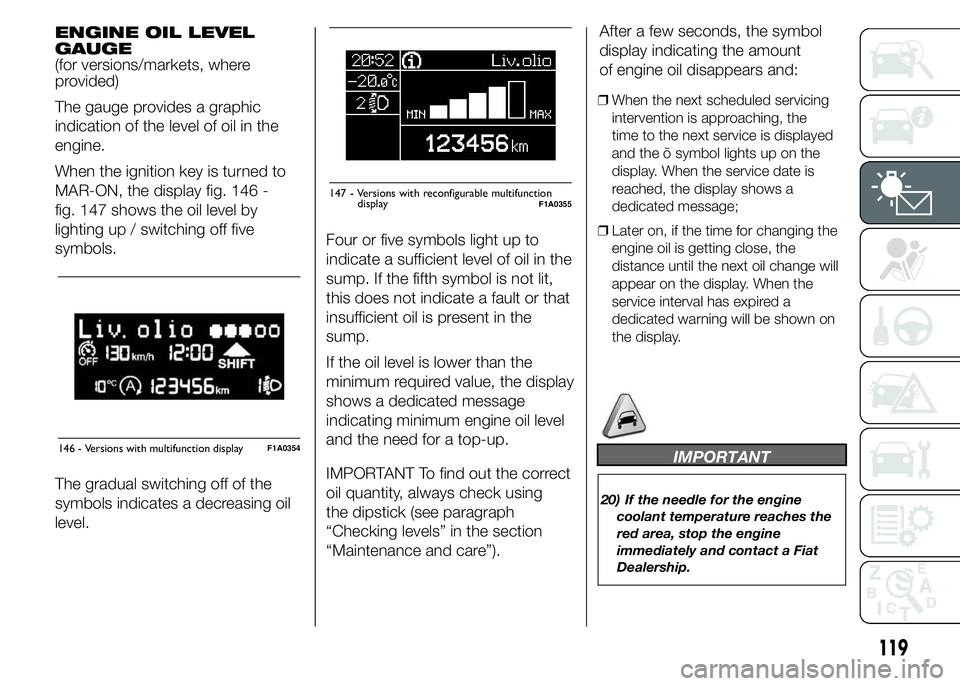
ENGINE OIL LEVEL
GAUGE
(for versions/markets, where
provided)
The gauge provides a graphic
indication of the level of oil in the
engine.
When the ignition key is turned to
MAR-ON, the display fig. 146 -
fig. 147 shows the oil level by
lighting up / switching off five
symbols.
The gradual switching off of the
symbols indicates a decreasing oil
level.Four or five symbols light up to
indicate a sufficient level of oil in the
sump. If the fifth symbol is not lit,
this does not indicate a fault or that
insufficient oil is present in the
sump.
If the oil level is lower than the
minimum required value, the display
shows a dedicated message
indicating minimum engine oil level
and the need for a top-up.
IMPORTANT To find out the correct
oil quantity, always check using
the dipstick (see paragraph
“Checking levels” in the section
“Maintenance and care”).After a few seconds, the symbol
display indicating the amount
of engine oil disappears and:
❒When the next scheduled servicing
intervention is approaching, the
time to the next service is displayed
and the õ symbol lights up on the
display. When the service date is
reached, the display shows a
dedicated message;
❒Later on, if the time for changing the
engine oil is getting close, the
distance until the next oil change will
appear on the display. When the
service interval has expired a
dedicated warning will be shown on
the display.
IMPORTANT
20) If the needle for the engine
coolant temperature reaches the
red area, stop the engine
immediately and contact a Fiat
Dealership.
146 - Versions with multifunction displayF1A0354
Liv.olio
MAX MIN
147 - Versions with reconfigurable multifunctionF1A0355
119
display
Page 131 of 367
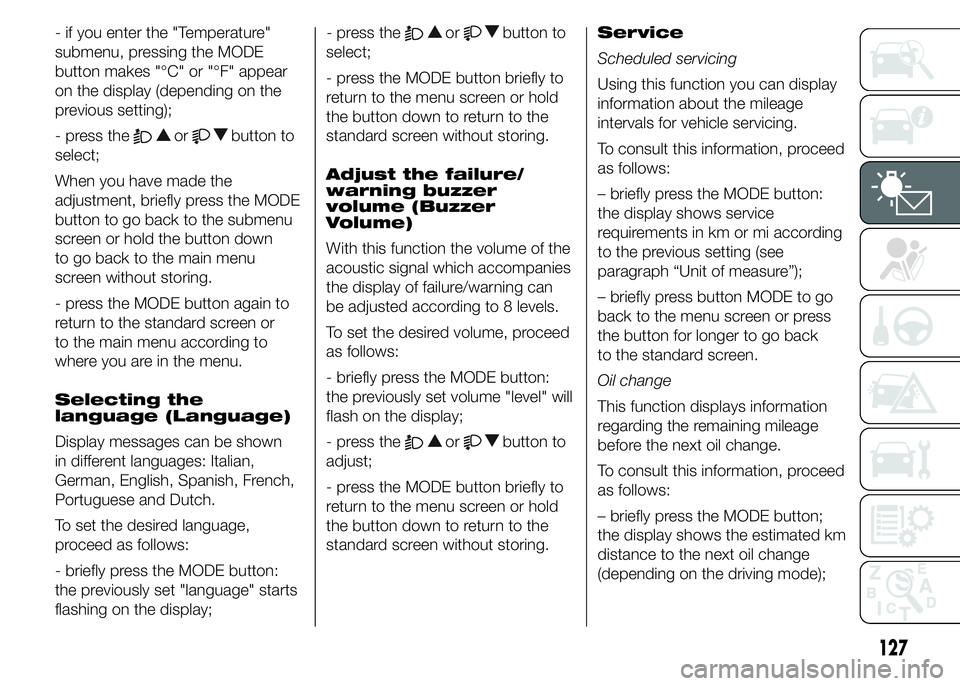
- if you enter the "Temperature"
submenu, pressing the MODE
button makes "°C" or "°F" appear
on the display (depending on the
previous setting);
- press the
orbutton to
select;
When you have made the
adjustment, briefly press the MODE
button to go back to the submenu
screen or hold the button down
to go back to the main menu
screen without storing.
- press the MODE button again to
return to the standard screen or
to the main menu according to
where you are in the menu.
Selecting the
language (Language)
Display messages can be shown
in different languages: Italian,
German, English, Spanish, French,
Portuguese and Dutch.
To set the desired language,
proceed as follows:
- briefly press the MODE button:
the previously set "language" starts
flashing on the display;- press the
orbutton to
select;
- press the MODE button briefly to
return to the menu screen or hold
the button down to return to the
standard screen without storing.
Adjust the failure/
warning buzzer
volume (Buzzer
Volume)
With this function the volume of the
acoustic signal which accompanies
the display of failure/warning can
be adjusted according to 8 levels.
To set the desired volume, proceed
as follows:
- briefly press the MODE button:
the previously set volume "level" will
flash on the display;
- press the
orbutton to
adjust;
- press the MODE button briefly to
return to the menu screen or hold
the button down to return to the
standard screen without storing.Service
Scheduled servicing
Using this function you can display
information about the mileage
intervals for vehicle servicing.
To consult this information, proceed
as follows:
– briefly press the MODE button:
the display shows service
requirements in km or mi according
to the previous setting (see
paragraph “Unit of measure”);
– briefly press button MODE to go
back to the menu screen or press
the button for longer to go back
to the standard screen.
Oil change
This function displays information
regarding the remaining mileage
before the next oil change.
To consult this information, proceed
as follows:
– briefly press the MODE button;
the display shows the estimated km
distance to the next oil change
(depending on the driving mode);
127
Page 142 of 367
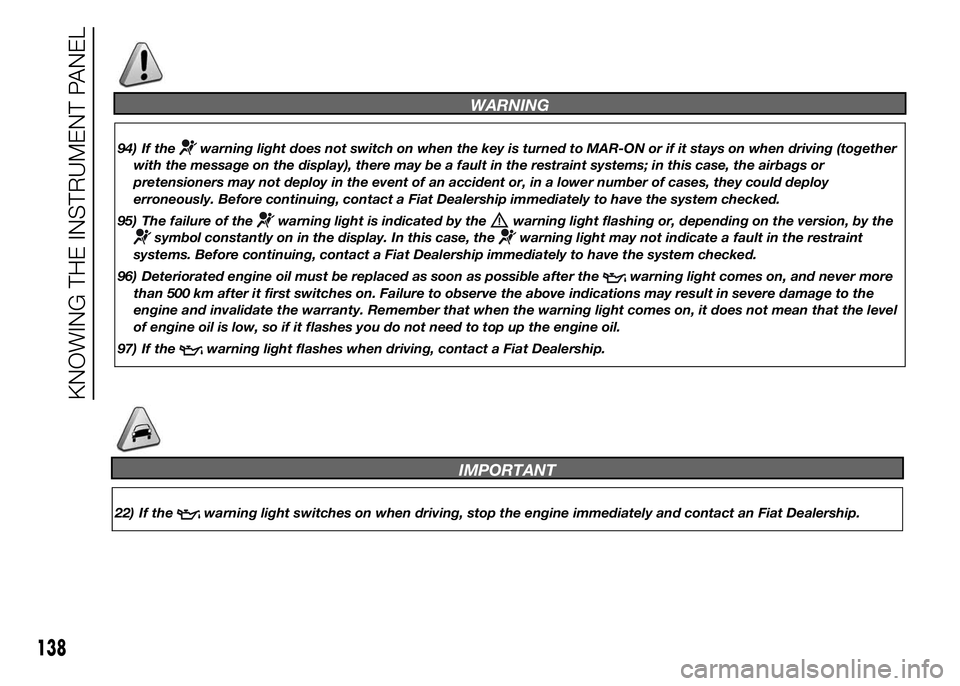
WARNING
94) If thewarning light does not switch on when the key is turned to MAR-ON or if it stays on when driving (together
with the message on the display), there may be a fault in the restraint systems; in this case, the airbags or
pretensioners may not deploy in the event of an accident or, in a lower number of cases, they could deploy
erroneously. Before continuing, contact a Fiat Dealership immediately to have the system checked.
95) The failure of the
warning light is indicated by thewarning light flashing or, depending on the version, by the
symbol constantly on in the display. In this case, thewarning light may not indicate a fault in the restraint
systems. Before continuing, contact a Fiat Dealership immediately to have the system checked.
96) Deteriorated engine oil must be replaced as soon as possible after the
warning light comes on, and never more
than 500 km after it first switches on. Failure to observe the above indications may result in severe damage to the
engine and invalidate the warranty. Remember that when the warning light comes on, it does not mean that the level
of engine oil is low, so if it flashes you do not need to top up the engine oil.
97) If the
warning light flashes when driving, contact a Fiat Dealership.
138
KNOWING THE INSTRUMENT PANEL
IMPORTANT
22) If thewarning light switches on when driving, stop the engine immediately and contact an Fiat Dealership.
Page 189 of 367

SAVING FUEL
Some useful tips are given below
for fuel saving and reducing harmful
emissions of CO2 and other
pollutants (nitrogen oxides, unburnt
hydrocarbons, Particulate Matter
(PM), etc.).
GENERAL
CONSIDERATIONS
The general factors that affect fuel
consumption are listed below.
Vehicle maintenance
Have checks and adjustments
carried out in accordance with the
“Scheduled Servicing Plan”.
Tyres
Check the tyre pressures at least
once every four weeks: if the
pressure is too low, consumption
levels increase as resistance to
rolling is higher.Unnecessary loads
Do not travel with an overloaded
luggage compartment. The weight
of the vehicle (especially when
driving in town) and its geometry
greatly affect fuel consumption and
stability.
Roof rack/ski rack
Remove the roof rack or the ski
rack from the roof after use. These
accessories decrease aerodynamic
penetration of the vehicle and
have a negative effect on fuel
consumption. When transporting
particularly large objects, use a
trailer if possible.
Electric devices
Use electrical devices only for the
amount of time needed. The heated
rear window, additional headlights,
windscreen/rear window wipers
and heater fan need a considerable
amount of energy, therefore
increasing fuel consumption (by up
to 25% in the urban cycle).Climate control
system
Air conditioning leads to higher fuel
consumption (on average up to
+20%). If the temperature outside
permits, try and use the ventilation
only.
Devices for
aerodynamic control
The use of non-certified spoilers
may adversely affect air drag and
fuel consumption.
DRIVING STYLE
The main driving styles that affect
fuel consumption are listed below.
Cranking
Do not warm up the engine at low
or high revs when the vehicle is
stationary; this causes the engine
to warm up more slowly, thereby
increasing fuel consumption and
emissions. It is therefore advisable
to move off immediately, slowly,
avoiding high speeds: in this way
the engine will warm up more
quickly.
185
Page 238 of 367
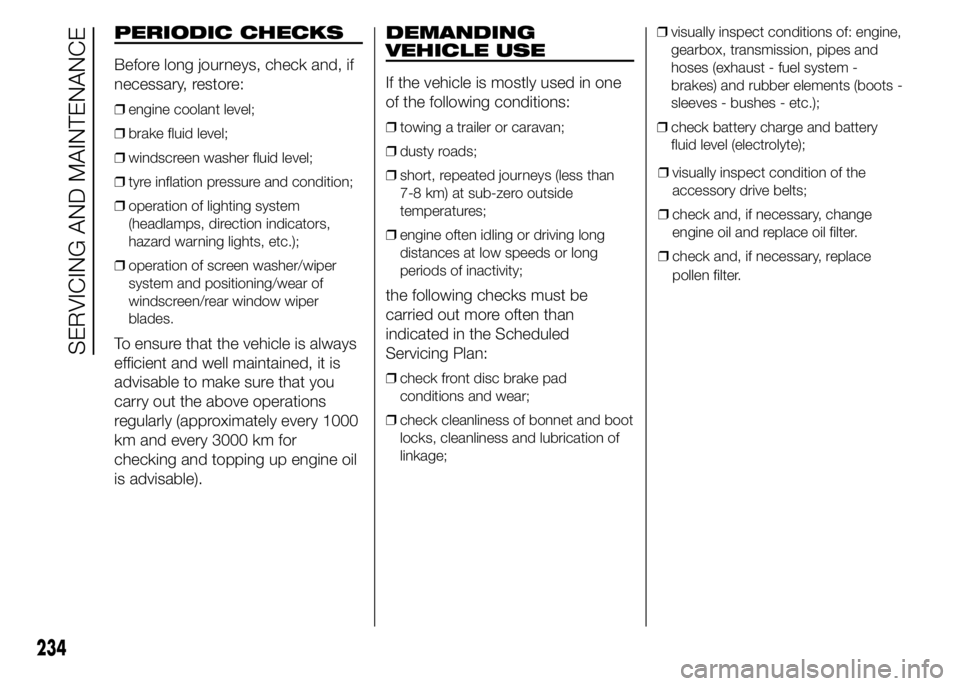
PERIODIC CHECKS
Before long journeys, check and, if
necessary, restore:
❒engine coolant level;
❒brake fluid level;
❒windscreen washer fluid level;
❒tyre inflation pressure and condition;
❒operation of lighting system
(headlamps, direction indicators,
hazard warning lights, etc.);
❒operation of screen washer/wiper
system and positioning/wear of
windscreen/rear window wiper
blades.
To ensure that the vehicle is always
efficient and well maintained, it is
advisable to make sure that you
carry out the above operations
regularly (approximately every 1000
km and every 3000 km for
checking and topping up engine oil
is advisable).
DEMANDING
VEHICLE USE
If the vehicle is mostly used in one
of the following conditions:
❒towing a trailer or caravan;
❒dusty roads;
❒short, repeated journeys (less than
7-8 km) at sub-zero outside
temperatures;
❒engine often idling or driving long
distances at low speeds or long
periods of inactivity;
the following checks must be
carried out more often than
indicated in the Scheduled
Servicing Plan:
❒check front disc brake pad
conditions and wear;
❒check cleanliness of bonnet and boot
locks, cleanliness and lubrication of
linkage;❒visually inspect conditions of: engine,
gearbox, transmission, pipes and
hoses (exhaust - fuel system -
brakes) and rubber elements (boots -
sleeves - bushes - etc.);
❒check battery charge and battery
fluid level (electrolyte);
❒visually inspect condition of the
accessory drive belts;
❒check and, if necessary, change
engine oil and replace oil filter.
❒check and, if necessary, replace
pollen filter.
234
SERVICING AND MAINTENANCE
Page 239 of 367
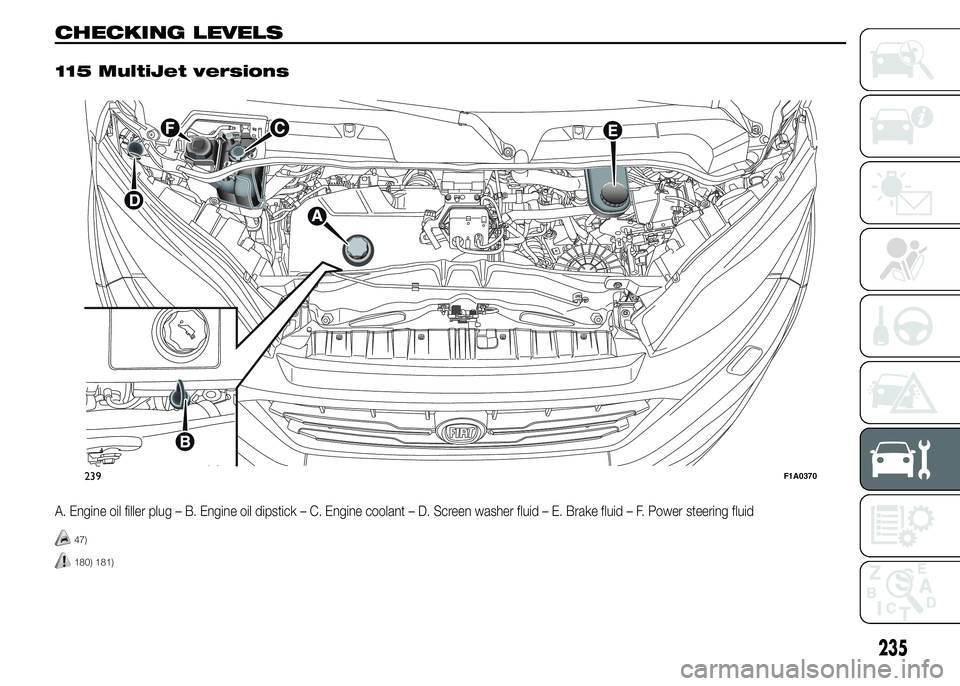
CHECKING LEVELS.
115 MultiJet versions
A. Engine oil filler plug – B. Engine oil dipstick – C. Engine coolant – D. Screen washer fluid – E. Brake fluid – F. Power steering fluid
47)
180) 181)
239F1A0370
235
Page 242 of 367

ENGINE OIL
48)
Check the oil level a few minutes
(about 5) after the engine has
stopped, with the vehicle parked on
level ground.
The oil level must be between the
MIN and MAX marks on the
dipstick B fig. 239 - fig. 240 - fig.
241.
The range between the MIN and
MAX marks corresponds to about 1
litre of oil.
If the oil level is near or under the
MIN mark, add oil through the filler
A fig. 239 - fig. 240 - fig. 241,
until it reaches the MAX mark.
The oil level must never exceed the
MAX mark.
Engine oil
consumption
The maximum engine oil
consumption is usually 400 grams
every 1000 km.
When the vehicle is new, the engine
needs to be run in, therefore the
engine oil consumption can only be
considered stabilised after the first
5,000–6,000 km.IMPORTANT The oil consumption
depends on driving style and the
conditions under which the vehicle
is used.
IMPORTANT After adding or
changing the oil, let the engine run
for a few seconds and wait a few
minutes after switching it off before
checking the level.
IMPORTANT Always top up using
engine oil of the same
specifications as that already in the
engine.
ENGINE COOLANT
49)182)
The coolant level must be checked
when the engine is cold and must
range between the MIN and MAX
marks on the reservoir.
If the level is to low, operate as
follows:
❒remove the plastic cover A fig. 242,
rotating the locking screws B fig.
242 counter-clockwise, to access the
filler of the reservoir;❒slowly pour a mixture of 50%
demineralised water and 50%
PARAFLU
UPfrom PETRONAS
LUBRICANTS through the reservoir
filler C fig. 239 - fig. 240 - fig. 241
until the level is close to MAX.
A 50-50 mixture of PARAFLUUPand
distilled water gives freeze
protection up to –35°C.
When the vehicle is used in
particularly harsh weather
conditions, we recommend using a
60-40 mixture of PARAFLU
UPand
demineralised water.
242F1A0336
238
SERVICING AND MAINTENANCE
Page 244 of 367
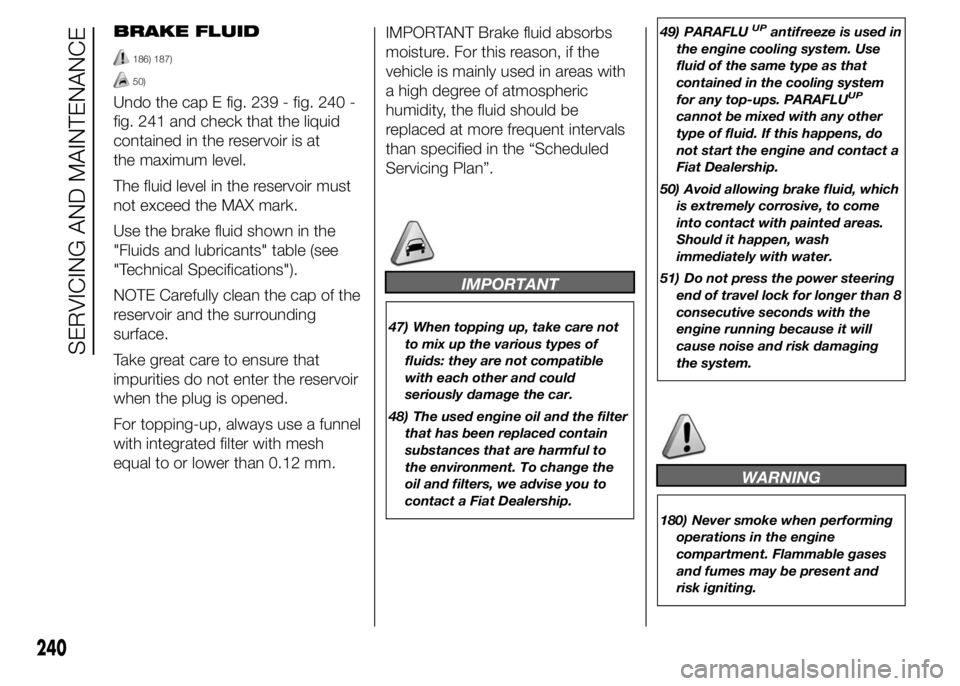
BRAKE FLUID
186) 187)
50)
Undo the cap E fig. 239 - fig. 240 -
fig. 241 and check that the liquid
contained in the reservoir is at
the maximum level.
The fluid level in the reservoir must
not exceed the MAX mark.
Use the brake fluid shown in the
"Fluids and lubricants" table (see
"Technical Specifications").
NOTE Carefully clean the cap of the
reservoir and the surrounding
surface.
Take great care to ensure that
impurities do not enter the reservoir
when the plug is opened.
For topping-up, always use a funnel
with integrated filter with mesh
equal to or lower than 0.12 mm.IMPORTANT Brake fluid absorbs
moisture. For this reason, if the
vehicle is mainly used in areas with
a high degree of atmospheric
humidity, the fluid should be
replaced at more frequent intervals
than specified in the “Scheduled
Servicing Plan”.
IMPORTANT
47) When topping up, take care not
to mix up the various types of
fluids: they are not compatible
with each other and could
seriously damage the car.
48) The used engine oil and the filter
that has been replaced contain
substances that are harmful to
the environment. To change the
oil and filters, we advise you to
contact a Fiat Dealership.49) PARAFLU
UPantifreeze is used in
the engine cooling system. Use
fluid of the same type as that
contained in the cooling system
for any top-ups. PARAFLU
UP
cannot be mixed with any other
type of fluid. If this happens, do
not start the engine and contact a
Fiat Dealership.
50) Avoid allowing brake fluid, which
is extremely corrosive, to come
into contact with painted areas.
Should it happen, wash
immediately with water.
51) Do not press the power steering
end of travel lock for longer than 8
consecutive seconds with the
engine running because it will
cause noise and risk damaging
the system.
WARNING
180) Never smoke when performing
operations in the engine
compartment. Flammable gases
and fumes may be present and
risk igniting.
240
SERVICING AND MAINTENANCE
Page 362 of 367

INDEX
A
BS .............................................. 82
Additional heater ............................ 42
Additional rear climate control
(Panorama/Combi) ....................... 47
Additional rear heating
(Panorama/Combi) ....................... 47
Advice for extending battery life...... 243
Air cleaner ...................................... 241
Air suspension ............................... 70
Arrangement possibilities for
Universal Isofix child restraint
system on seats of vehicle ........... 166
Ashtray .......................................... 67
ASR system ................................... 84
ASR (system) ................................. 84
Automatic climate control
system ......................................... 35
Automatic headlight sensor ............ 51
Battery (disconnector) ................... 62
Battery disconnector ...................... 62
Battery
– Replacement ............................. 242
Battery (recharging) ........................ 225
Battery replacement ....................... 242
body paintwork identification
plate............................................. 254
Bodywork
– Advice for preserving the
bodywork .................................. 248– Exterior and underbody
warranty .................................... 248
– Protection from atmospheric
agents ....................................... 248
Bodywork version .......................... 256
Bonnet ........................................... 79
Bottle replacement ......................... 206
Brake fluid ...................................... 240
Brakes
– specifications ............................ 262
Bulbs
– types of bulbs ........................... 209
Bump starting ................................ 198
Cab glove compartment ............... 68
Capucine ....................................... 68
Carrying children safely
– Arrangement possibilities for
child restraint systems ............... 162
– Child restraint systems .............. 160
– Safety regulations ...................... 163
Central locking ............................... 62
Changing a bulb............................. 208
Changing an interior bulb ............... 216
Chassis marking ............................ 254
Checking and restoring pressure .... 206
Checking levels .............................. 235
Cigar lighter.................................... 66
Clutch ............................................ 260
CO2 emissions............................... 335Compartment beneath
passenger side front seat ............. 65
Controls ......................................... 60
Cruise Control ................................ 55
Daytime Running Lights ................ 49
Dead lock ...................................... 73
Demanding vehicle use .................. 234
Desk/Book rest .............................. 67
Diesel particulate filter (DPF) ........... 111
Diffusers ......................................... 29
Dimensions .................................... 268
Dipped headlights .................... 49-212
Direction indicators ................... 50-213
Display
– Standard screen ........................ 120
Door pockets ................................. 65
Doors ............................................. 72
DPF (particulate filter) ..................... 111
Driving Advisor (system) ................. 92
Driving style.................................... 185
Electric windows ........................... 78
Electronic alarm ............................. 13
Engine codes ................................. 256
Engine coolant ............................... 238
Engine coolant temperature
indicator ....................................... 118
Engine............................................ 258
Engine marking .............................. 255
Engine oil ....................................... 238
INDEX